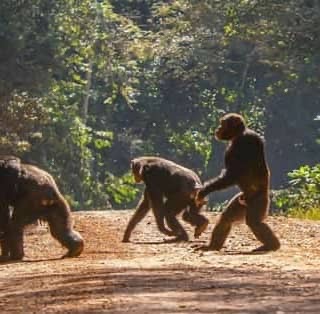Ugandan National Parks: Kibale Forest National Park
- AshleyDawn
- May 9
- 6 min read
Updated: May 10
What Makes Kibale Forest National Park Unique in Africa
Explore the unparalleled biodiversity of Kibale Forest National Park, located in Africa. This pristine wilderness is renowned for its rich tapestry of flora and fauna, making it a haven for nature enthusiasts and wildlife lovers alike. From towering trees to vibrant bird species, Kibale Forest National Park offers a captivating glimpse into the wonders of the natural world. Immerse yourself in the symphony of sounds that echo through the forest, creating a sensory experience like no other. Whether you're a seasoned adventurer or a first-time visitor, Kibale Forest National Park promises an unforgettable journey through one of Africa's most extraordinary ecosystems.

Ecosystem of Kibale Forest National Park
Kibale Forest National Park boasts a diverse and rich ecosystem that supports a wide array of flora and fauna. It contains a mix of tropical rainforest, grassland and swamp.
The vegetation in Kibale Forest National Park is equally impressive, with a mosaic of different habitats ranging from dense forest to open grasslands. The forest is characterized by towering trees, vibrant ferns, and a variety of colorful flowers. The diverse plant life not only provides food and shelter for the animals but also plays a crucial role in maintaining the delicate balance of the ecosystem.
Kibale Forest National Park stands as a prime example of a thriving and biodiverse ecosystem, offering a glimpse into the wonders of nature and the importance of preserving such valuable habitats for future generations to enjoy and learn from.
Land Animals You Might See in Kibale Forest National Park
It is renowned for its high biodiversity and is a haven for numerous species of plants and animals. The forest is home to over 60 species of mammals, including the iconic chimpanzees, as well as other primates such as red colobus monkeys and L'Hoest's monkeys. Additionally, Kibale Forest National Park is a birdwatcher's paradise, with over 375 species of birds recorded within its boundaries.
Kibale Forest National Park has one of the highest diversity and concentration of primates in Africa. It is home to a large number of endangered chimpanzees, as well as the red colobus monkey (status: Endangered) and the rare L'Hoest's monkey (Vulnerable). There are 13 species of primates in Kibale Forest National Park.
Chimpanzees: Kibale Forest National Park is renowned for its population of chimpanzees, making it one of the best places in the world to observe these intelligent primates in their natural habitat. The forest provides a safe haven for these endangered animals, allowing visitors to witness their social behaviors and interactions.
Red Colobus Monkeys: These striking primates with their vibrant red fur are a common sight in Kibale Forest National Park. Watching them swing gracefully through the trees is a memorable experience that highlights the beauty of the forest ecosystem.
L'Hoest's Monkeys: Another primate species found in Kibale Forest National Park, L'Hoest's monkeys are known for their distinctive white beards and dark fur. Observing these agile creatures as they move through the forest canopy is a true delight for nature enthusiasts.
Olive Baboons: These social and highly adaptable monkeys are often seen foraging for food in Kibale Forest National Park. Their presence adds to the rich tapestry of wildlife that calls the forest home, offering visitors a glimpse into the intricate dynamics of primate societies.
Red-tailed Monkeys: With their striking red tails and expressive faces, red-tailed monkeys are a charming sight in Kibale Forest National Park. Watching them play and interact in their natural environment provides insight into the interconnectedness of the forest's inhabitants.
Types of Plants Unique to Kibale Forest National Park
Within the lush expanse of Kibale Forest National Park, a treasure trove of plant species thrives, many of which are found nowhere else on Earth. These unique botanical wonders have evolved over time to adapt to the specific conditions and ecosystem of this remarkable forest. From towering canopy giants to delicate forest floor dwellers, Kibale Forest National Park boasts a diverse array of flora that captivates researchers, nature enthusiasts, and conservationists alike.
Among the types of plants that call Kibale Forest National Park home are rare orchids, vibrant ferns, and towering mahogany trees. Each species plays a crucial role in maintaining the delicate balance of this ecosystem, contributing to the overall health and biodiversity of the forest. The intricate interplay between these plants and the myriad of animal species that inhabit Kibale Forest National Park underscores the interconnectedness of life within this unique habitat.
Exploring the depths of Kibale Forest National Park reveals a botanical wonderland unlike any other, where endemic plant species paint a vivid tapestry of colors, shapes, and textures. Scientists continue to study these unique plants to unlock the secrets of their evolution and ecological significance, shedding light on the intricate web of life that sustains Kibale Forest National Park.
Average Temperature, Elevation and Weather
- Average temperatures: average daytime temperatures around 27°C (81°F), nighttime temperatures around 15°C (59°F)
- Elevation: elevation ranging from 928m to 1,568m (3,045ft to 5,144ft) above sea level;
- Weather: Kibale Forest National Park in Uganda experiences a moist, temperate climate. the park has no distinct dry season but generally sees drier periods between December-February and June-July with rain possible year-round.
Tribal History in Kibale Forest National Park & Bigodi
Discover the captivating tapestry of cultural heritage woven into the very fabric of Kibale Forest National Park and the surrounding town of Bigodi. Embark on a journey through time as you unravel the intricate stories of the indigenous tribes whose roots run deep in these lush natural surroundings. Immerse yourself in the traditions, beliefs, and customs that have shaped the identity of the local communities, forging a profound connection between people and land that transcends generations. From ancient rituals to modern-day practices, each aspect of the tribal history in Kibale Forest National Park and Bigodi unveils a rich tapestry of knowledge, wisdom, and resilience. By delving into this fascinating heritage, you not only gain a deeper appreciation for the cultural diversity of the region but also witness the enduring legacy of harmonious coexistence between humans and the natural world.
The history of tribal communities in Kibale Forest National Park and Patrick's hometown of Bigodi includes the Batooro and Bakiga tribes:
The largest tribe in the area around Kibale Forest National Park, the Batoro have a rich cultural heritage that includes the Omukama (Toro king) and the kingdom. The owner of Uganda African Safari Company is Batooro!
A smaller tribe in the area, the Bakiga are believed to have migrated to the area in the 1950s. They preserve their culture through dance, folktales, and language.
History of Kibale Forest National Park
Kibale Forest is a national park located in Uganda. It was established in 1993 to protect a diverse array of wildlife, including over 1,450 chimpanzees. The forest has a long history of human habitation, with evidence of human activity dating back to the Stone Age.
During the colonial period, the area was used for logging and farming, which led to deforestation and habitat destruction. In the 1970s and 1980s, conservation efforts began to protect the forest and its inhabitants.
Today, Kibale Forest National Park is a popular destination for ecotourism, offering opportunities for visitors to see chimpanzees, as well as other primates, birds, and butterflies. The forest is also an important research site, with ongoing studies on primate behavior, ecology, and conservation.
Facts About Kibale Forest National Park
Kibale Forest National Park is a biodiverse tropical rainforest located in Uganda. It is home to a wide variety of wildlife species, including over 350 species of birds and 70 species of mammals. The forest is particularly famous for its population of chimpanzees, making it a popular destination for primate enthusiasts and researchers alike.
One of the unique features of Kibale Forest National Park is its dense canopy, which provides a habitat for a rich array of plant species, some of which are endemic to the region. The forest also plays a crucial role in maintaining the ecological balance of the area, serving as a watershed for several rivers and streams.
Moreover, Kibale Forest National Park is also known for its important conservation efforts and research initiatives like the Kibale Chimpanzee Project, the Ngogo Chimpanzee Project, and The Kibale Ecohealth Project. The forest serves as a valuable research site for scientists studying primate behavior, ecology, sociology and biodiversity. Conservation organizations work tirelessly to protect the forest and its inhabitants from threats such as deforestation and poaching, ensuring the long-term survival of this unique ecosystem. Patrick, owner of Uganda African Safari Company, is a BIGODI local and a leader within the Kibale Conservation Project.
What You Can Do In The Bigodi Area
Visitors to Kibale Forest National Park have the opportunity to engage in activities such as guided nature and swamp walks, birdwatching, and chimpanzee tracking. The Bigodi Wetland Sanctuary is run by the Kibale Association for Rural and Environmental Development (KAFRED). The name comes from the Rutooro dialect word "Kugodya" which means "to walk tiredly". This is because people would often have to rest while walking through the swamp on their way to Kibale Forest National Park.
Visitors can also participate in Cultural walking tours through the Bigodi
Village which allows people to experience the daily culture of the indigenous Batooro people and the immigrant Bakiga people. The walking tour can include a visit to Banana Man's house to see him make banana juice and beer, a coffee making experience, meeting a traditional healer, watching women weave baskets or watching a live dance performance.

































































































Comments